From inside (document excerpt):
SAFETY PRECAUTIONS If your chain saw Is operating properly and Is efficiently maintained, it will give you many hours of trouble-free service with no risk to personnel. It is well to remember, however, that chain saw equipment is potentially dangerous and should always be regarded with respect. The following precautions should be kept in mind at all times. 1. Never touch or try to stop a moving chain with your hand. 2. Keep your chain sharp and in good condition. A dull and improperly filed chain will cause the saw to buck and jump.
This can result in injury. 3. Start your engine without assistance. A moving chain can Inflict serious injury. 4. Stop engine before carrying saw between trees. This will eliminate the possibility of a branch or twig opening the throttle and causing the chain to revolve. Carry saw with guide and chain behind you. 6. Be sure of your footing when operating the saw. 6. Select a fa path prior to felling the u. 7. Plan your work before starting the cut. Be sure the bumper is against the tree or log before starting · ·. otherwise the chain will Jerk the engine toward the log and serious damage can occur. 8. Beware of falling limbs. It is edvisable to wear a safety helmet. 2 / AS A CHAIN SAW OWNER YOU SHOULD Fill in and mail the warranty card which accompanied this product at time of purchase. Record your engine serial number and retain for future reference. Read this Owner Manual carefully and keep it available for ready reference. Use the proper fuel mixture and lubricants at all times. Keep your chain saw clean. Keep the chain sharp for best cutting results. Regularly check all screws, nuts, and bolts for looseness and tighten whenever needed. Have your authorized service dealer replace badly worn or broken parts immediately. Never operate your saw in a damaged condition, this will only cause greater and more expensive damage. 3 LOCATION OF CONTROLS 1. THROTTLE TRIGGER – pull back to increase speed 2. THROTTLE LOCK 3. CHOKE LEVER-pull out to choke 4. FILLER CAP-CHAIN OIL 5. FILLER CAP-FUEL 6. STARTER HANDLE – pull to operate 7. AIR FILTER COVER 8. CHAIN OILER BUTTON-push to operate (Use frequently while cutting) 9. IGNITION SWITCH – Flip to “ON ” for starting- “OFF ” to stop engine 3. Place chain around the sprocket with sharp edge of cutting teeth facing forward on top of bar. Engage drive links tangs between sprocket teeth. 4. Starting at the top of bar, gradually work the chain into groove of the bar until all drive links are engaged in the bar groove. 1. Remove the bar mounting nuts, washers, bar clamp and outer bar plate. (Note position of bar plate.) 5. Slide bar forward and fit adjustment hole in bar over adiusting pin. 2. Mount the slotted end of bar over bar mounting studs and slide bar rearward as far as possible. 6. Place outer guide plate over mounting studs (note position of outer plate). Install bar clamp and nuts. Tighten nuts finger tight. FUEL MIXTURE ‘ I The chain requires frequent lubriciltion during cutting. Fill chain oil reservoir with clean SAE 30 oil in the warmer months and use SAE 10 oil during colder weather. Oil is pumped from reservoir by a manual pump located just to the left of handle. REMEMBER: Fill chain oil reservoir every time you fill the gas tank. Raise tip of bar and turn the adjusting screw (clockwise) until the bottom of all tie straps of chain make contact with bottom of bar rails. There should be light tension in the chain, but the chain should move around bar freely, when pulled by hand. Continue to hold the tip of the bar upward and tighten bar mounting nuts securely with bar wrench. For a Roller Nose Bar the chain must be much tighter. Follow the same procedures outlined for the Chain Adjustment for the Hard Nose Bar only adjust the tension so chain resists being lifted out of the bar groove by hand, yet, can be pulled around the guide bar by hand. Run engine slowly for a minute or two while keeping the chain well oiled. Stop engine and check chain tension and readjust if necessary. Check chain tension frequently during the first hour of cutting. Running chain too loosely or too tightly will cause excessive wear to bar and chain. It is important that you keep the chain sharp and properly filed at all times. (See Chain Filing Instructions, Page 13.)


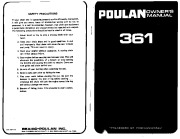 Poulan Owners Manual - 1 of 16
Poulan Owners Manual - 1 of 16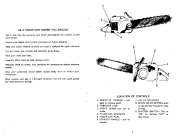 Poulan Owners Manual - 2 of 16
Poulan Owners Manual - 2 of 16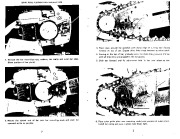 Poulan Owners Manual - 3 of 16
Poulan Owners Manual - 3 of 16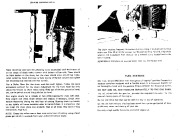 Poulan Owners Manual - 4 of 16
Poulan Owners Manual - 4 of 16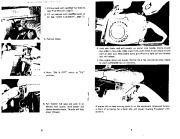 Poulan Owners Manual - 5 of 16
Poulan Owners Manual - 5 of 16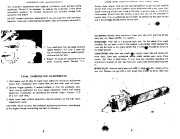 Poulan Owners Manual - 6 of 16
Poulan Owners Manual - 6 of 16 Poulan Owners Manual - 7 of 16
Poulan Owners Manual - 7 of 16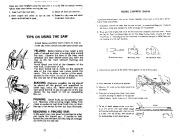 Poulan Owners Manual - 8 of 16
Poulan Owners Manual - 8 of 16 Poulan Owners Manual - 9 of 16
Poulan Owners Manual - 9 of 16 Poulan Owners Manual - 10 of 16
Poulan Owners Manual - 10 of 16